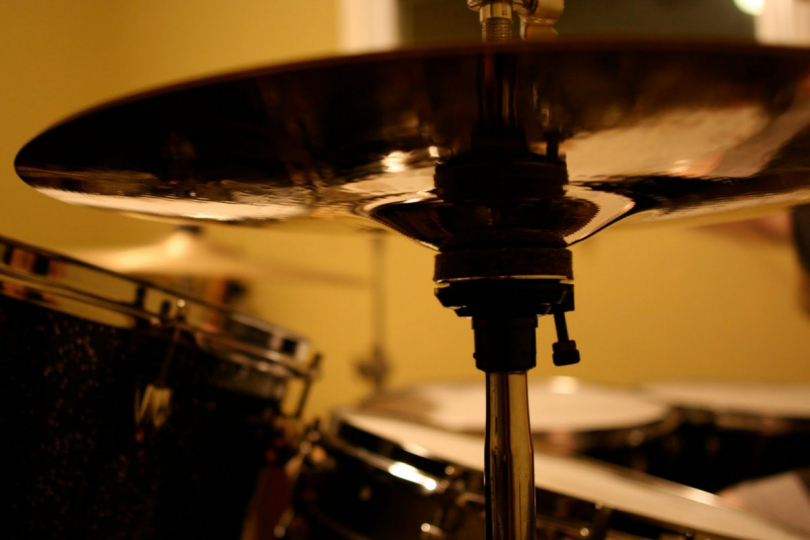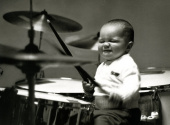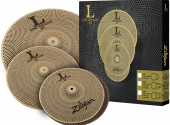
Drummer in a (Heart)beat: Choosing a Drumkit Made Easy
Maybe you know this scenario: a young, novice drum adept meets a more advanced, experienced colleague and starts picking their brain. Which instrument is best for a beginner? How much will it cost? Won't it break right away? And the advanced drummer doesn't know. I mean, not that they don't know anything at all, but they’re a bit lost in the current offer, because it's really overwhelming and it's almost not in human power to orient and recommend the "one and only" best thing on the market. So the conversation might look a little bit like this.
Beginner: I would like to start playing drums and I don't know what to get. Is there something universal, of good quality, that can be recommended to everyone?
Advanced: Hm, that's not so easy to answer. There is no one-size-fits-all, unbreakable instrument. First of all, though, I wonder how serious you are about drumming and music? Are you planning a professional career? Will you have the time, desire, and motivation to commit all your time, money, and energy to it? Or do you just want to play with your friends now and then, start a band, record a few songs, maybe eventually perform somewhere...?
Beginner: Well, I don't know much myself yet. I just want to learn some basics and play with my friends, I'm not thinking much further beyond that.
Advanced: That's understandable. Because if you choose a high-end instrument, the upper limit of investment and the range of choice is almost unlimited. So let's stick with the amateur playing option, for now with no prospect of a professional career. Do you have an idea of what kind of music you would like to play?
Beginner: Well, I like rock, I listen to Red Hot Chili Peppers, Foo Fighters, The Offspring and stuff.
Advanced: Yeah, so hard rock, heavy, punk, and stuff like that. I don't think you can go wrong if you get a cheaper drumkit from established manufacturers like Tama, Pearl, Sonor, Mapex, Yamaha, Gretsch, Ludwig, or PDP. Each of these manufacturers offer kits at very interesting prices between €400-800. You can choose from several sizes and colors from all manufacturers, and all kits come with solid, reliable mechanics.
Beginner: Are drum dimensions important?
Advanced: Nowadays, when everything is amplified—sometimes even much more than is needed—it is not so important to deal with the size or volume of the drums. With the cheaper ranges, projection is more important. And this is determined not only by the size of the drum, the material and the type of drum head, but mainly by the drummer and their playing. That's why I think that for a beginner, a kit with standard dimensions is suitable—that is, a big drum of 22 inches, toms in a combination of 10, 12, and 14 inches, or 12, 13, and 16. Try it out for yourself and if you want to play quieter music than rock over time, a smaller 20" or even 18" kick might suit you better. Same goes for toms. In recent years, the trend has been towards larger sizes, often in a combination of perhaps 14" and 18" plus a big 24" drum, but again—this is a matter of personal taste, which you will build up over time.
Beginner: Is it necessary to deal with the skins on such a cheap kit? I've heard that the "off brand" ones don't play very well.
Advanced: I don't think that’s a problem anymore these days. Maybe there are still some kits with really poor quality drumheads— it used to be pretty much standard and the first thing one had to do after buying such a kit was to replace the skins with a proven brand such as Remo or Evans, or more recently the popular Aquarian. Nowadays all manufacturers put Remo membranes on their kits, they just print their own logo on them. However, that doesn't mean that any Remo drumhead will suit you. There are dozens of types of them. Rather, in very general and superficial terms, it is true that for a thicker, more resonant, and fuller sound without much overtones, thicker skins or double skins should be chosen; while for a softer, ringing, very open sound, thinner skins are recommended. But even this is not without exception, you have to search and try it out for yourself.
With a new cheap kit I would probably deal mainly with the sound of the snare and the kick drum. That's kind of the basis of the kit. You'll probably get the snare drum with the kit in some standard 14" x 5" or 5.5" size (that's the depth of the drum). Its quality is absolutely crucial to the overall sound, so I would direct any investment in a drumhead mainly towards that. You can try different playing membranes, i.e. single, double, sandblasted, smooth, or with ventilation holes, as well as resonant membranes, which are almost without exception single-ply and clear. The sound of a snare drum is also greatly influenced by the choice of the snares, but that is another investment and a lot of tinkering, and you will surely figure that out for yourself in time, whether it makes sense for you or not.
If it happens that you don't get a bass drum with the manufacturer's drumhead, it will be quiet, obscured, without bass, try Evans Emad. I'm not a proponent of these skins on high-end instruments, however, many colleagues agree that a cheap drum plays better with one. A high quality, expensive instrument will often be drowned out by this membrane and have its dynamics unnecessarily clipped. Otherwise, I have personally had excellent experience with Remo Powerstroke 3 in both clear and sandblasted versions. Also, it could probably work well on any instrument.
Beginner: What about the mechanical parts of cheap kits? Are they reliable?
Advanced: I remember a time when the mechanics of cheap rigs weren't very good and soon broke down. Recently, reputable manufacturers have been taking great care of this part of cheap instruments as well, so I wouldn't worry about low quality pedals, stands, and mounts. At one time, cheap Basix or Stagg sets were very popular. When the Basixes were well tuned, they didn't play badly for the money. However, as far as mechanics were concerned, it was not a big win. Not to mention the Stagg sets. However, this shouldn't be a problem with the aforementioned established manufacturers. One can eventually buy a higher quality, sturdier pedal or stand for hi-hat, snare, or other cymbals. Again, there is a wide range of choice from virtually all manufacturers. As you gain experience, you will also find out what type of mechanics suit you. If you're going to use big, heavy cymbals, the stands that hold the cymbals need to be massive as well. In quieter music, with small or light cymbals, simple stands without double legs will suffice. After a few years of carrying mechanics between the rehearsal room, the car and the stage, your back will thank you for any kilograms of weight saved!
Advanced: Nowadays, when everything is amplified—sometimes even much more than is needed—it is not so important to deal with the size or volume of the drums. With the cheaper ranges, projection is more important. And this is determined not only by the size of the drum, the material and the type of drum skin, but mainly by the drummer and their playing. That's why I think that for a beginner, a kit with standard dimensions is suitable—that is, a big drum of 22 inches, toms in a combination of 10, 12, and 14 inches, or 12, 13, and 16. Try it out for yourself and if you want to play quieter music than rock over time, a smaller 20" or even 18" kick might suit you better. Same goes for toms. In recent years, the trend has been towards larger sizes, often in a combination of perhaps 14" and 18" plus a big 24" drum, but again—this is a matter of personal taste, which you will build up over time.
Beginner: I don't have to deal with that yet, but it might be an important aspect for me when dealing with mechanics someday. What about cymbals? Any tips?
Advanced: Basically the same applies to cymbals as to kits. There are several established and proven manufacturers and all of them are represented on the Czech market, so there are plenty to choose from. I would avoid the very cheapest sets. They may be sufficient for practicing, but they usually don't work in a band and you can't make much music with them. Try anything from brands such as Zildjian, Paiste, Sabian, Istanbul Mehmet, or Anatolian, and you'll be sure to find something you like! For heavier music, cymbals tend to be bigger and thicker, with clear projection. On the other hand, it has been my personal experience that a thinner cymbal is more flexible and adapts to a harder blow more easily than a thicker cymbal that won't bend but will crack straight away over time. However, this is not the rule, and with reasonable striking technique you shouldn't have cymbals cracking beyond a tolerable limit.
Beginner: Hm, thanks for the advice! So now I know everything and I can go shopping...
Advanced: Well, don't forget a few other components, often just as important as the kit itself. First of all, the stool. If you're going to spend even a few hours a day on it, it should be of the highest quality. A round stool is standard, and I would recommend a screw-in one with double legs. In this case, there's no point in saving weight like with those cymbal stands.
The choice of drumsticks is very important, but this is so specific that it is difficult to give any general advice. We all have different hands, different physiognomy and therefore different shapes and weights suit everyone. For loud music it is obviously better to choose larger and heavier drumsticks, the sound is fuller from them and one does not strain so much when playing, as the weight of the drumstick does enough work on its own. While a light mallet may feel more dexterous at first, it may not deliver the hard hitting punch needed in rock music. Check whether painted or unpainted mallets suit you, and definitely always test the balance. They just have to fit in your hand.
Also get a metronome and ear muffs. Sometimes plain drugstore earbuds are enough, but large covered mufflers work great. These can be purchased for a small amount of money at work supply stores. After all, a drummer's ears suffer and you don't want to be completely deaf at 50, do you?
Beginner: Yeah, I wouldn't have thought of that, good tip!
Advanced: We haven't talked at all about the gameplay itself yet. We haven't really talked about how to practice, what to do and how to avoid beginner mistakes. I know, you just want to play for fun with your friends for now, and maybe you'll never have higher ambitions. Still, I recommend you find a good teacher, under whose guidance you should avoid mistakes and possibly later pain. But that's a topic for another conversation and I must be off. I'm in a hurry to get to the rehearsal studio. I still enjoy it, even after all these years! Who would have thought it back then, when I was about your age and I started banging metal in the garage with my friends...
If you have found an error or typo in the article, please let us know by e-mail info@insounder.org.





